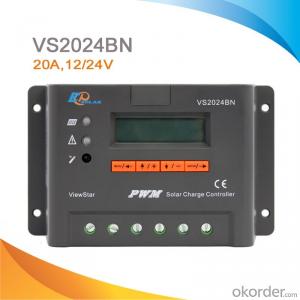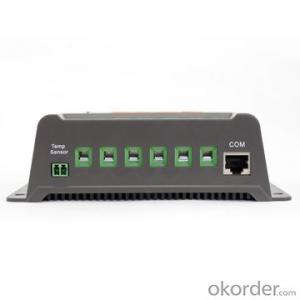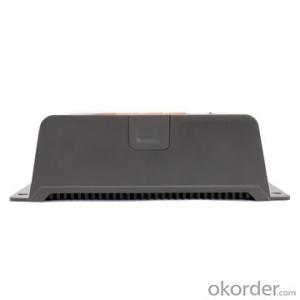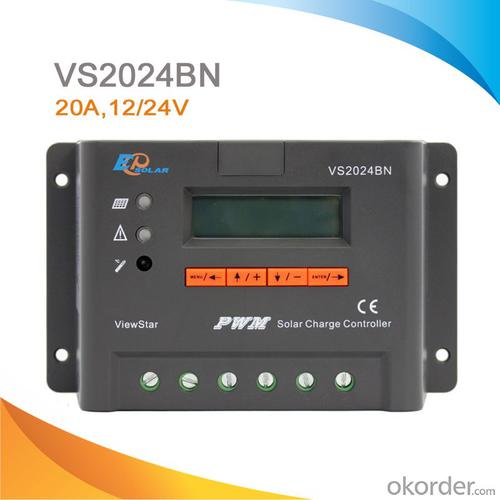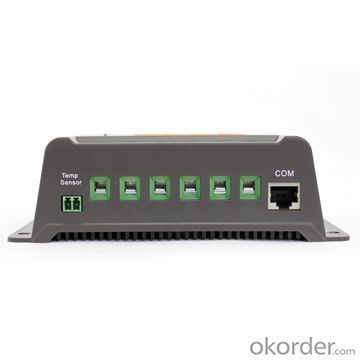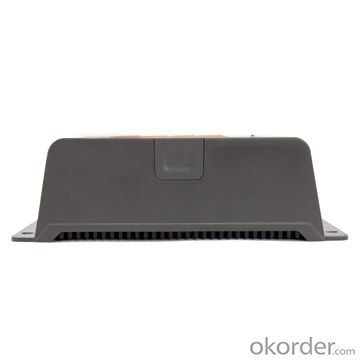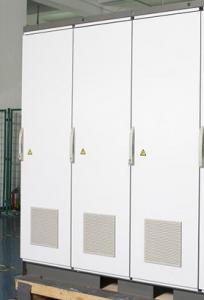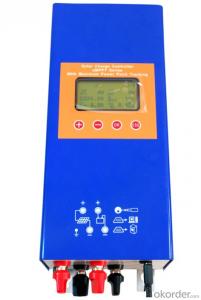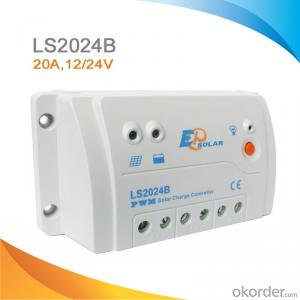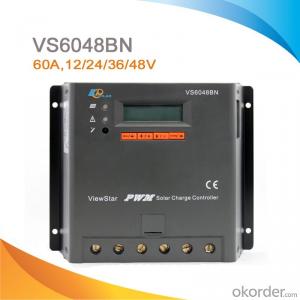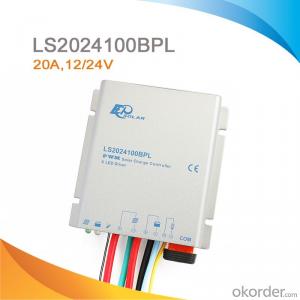LCD/LED High Quality PWM Solar anel charge controller/regulator 10a 12/24v with CE ROHS 20A ,12V/24V,VS2024BN
- Loading Port:
- Tianjin
- Payment Terms:
- TT or LC
- Min Order Qty:
- -
- Supply Capability:
- 10000 pc/month
OKorder Service Pledge
OKorder Financial Service
You Might Also Like
Features:
·Excellent EMC design
·32 bit MCU with high speed
·High efficient Series PWM charging
·Four battery type options: Sealed, Gel, Flooded, and USER
·Intelligent lighting and timer control for solar lighting system
·12 bit A/D high-precision sampling to ensure accuracy
·Use MOSFET as electronic switch
·Full control parameters setting and modification, diversified load control mode
·Humanized design of browser interface, undertake every operating conveniently
·Temperature compensation
·Adopt graphics dot-matrix LCD screen and HMI (human-machine interface) with 4 buttons,integrated menu displaying and operation
·Energy statistics function
·RS485 ports with MODBUS communication protocol
·Optional PC monitoring software and remote meter for real-time monitoring and battery management parameter setting
·Field upgradable firmware
Electronic Protections:
·PV short circuit protection
·PV reverse polarity protection
·Battery overcharge protection
·Battery over discharge protection
·Battery reverse polarity protection
·Load overload protection
·Load short circuit protection
·Overheating protection
Specification:
Model | cn1 | cn2 | cn3 | cn4 | cn5 |
Nominal system voltage | 12V/24V auto work | ||||
Rated battery current | 10A | 20A | 30A | 45A | 60A |
Rated load current | 10A | 20A | 30A | 45A | 60A |
Max. battery voltage | 32V | ||||
Equalize charging voltage | Sealed: 14.6V, Flooded: 14.8V, User-defined: 9~17V | ||||
Boost charging voltage | Gel: 14.2V, Sealed: 14.6V, Flooded: 14.8V, User-defined: 9~17V | ||||
Float charging voltage | Gel /Sealed /Flooded: 13.8V, User-defined: 9~17V | ||||
Low voltage reconnect voltage | Gel /Sealed /Flooded: 12.6V, User-defined: 9~17V | ||||
Low voltage disconnect voltage | Gel /Sealed /Flooded: 11.1V, User-defined: 9~17V | ||||
Self-consumption | ≤15mA(12V); ≤10mA(24V); ≤9mA(36V); ≤8mA(48V) | ||||
Grounding | Common negative | ||||
Temp. compensation | -3mV/°C/2V | ||||
Relative humidity | 10%~90% Non-condensation | ||||
Communication | RS485 / RJ45 interface | ||||
LCD temperature | -20°C ~ +70°C | ||||
Working temperature | -25°C ~ +55°C | ||||
Humidity | ≤95% N.C. | ||||
Enclosure | IP30 | ||||
Overall dimension | 162x85x40mm | 162x100x50mm | 200x103x58mm | 201x109x59mm | 205x129x67mm |
Terminals | 4mm2 | 10mm2 | 16mm2 | 35mm2 | 35mm2 |
Net weight | 0.2kg | 0.4kg | 0.7kg | 0.9kg | 1.3kg |
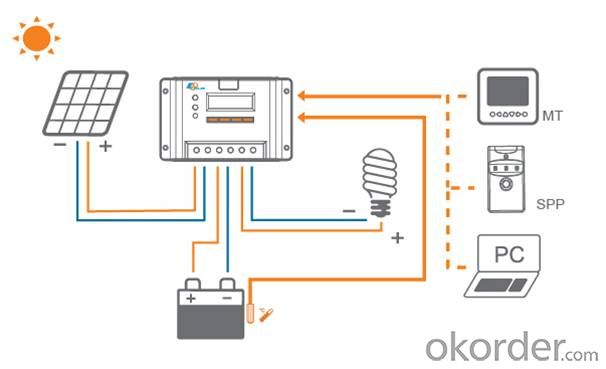

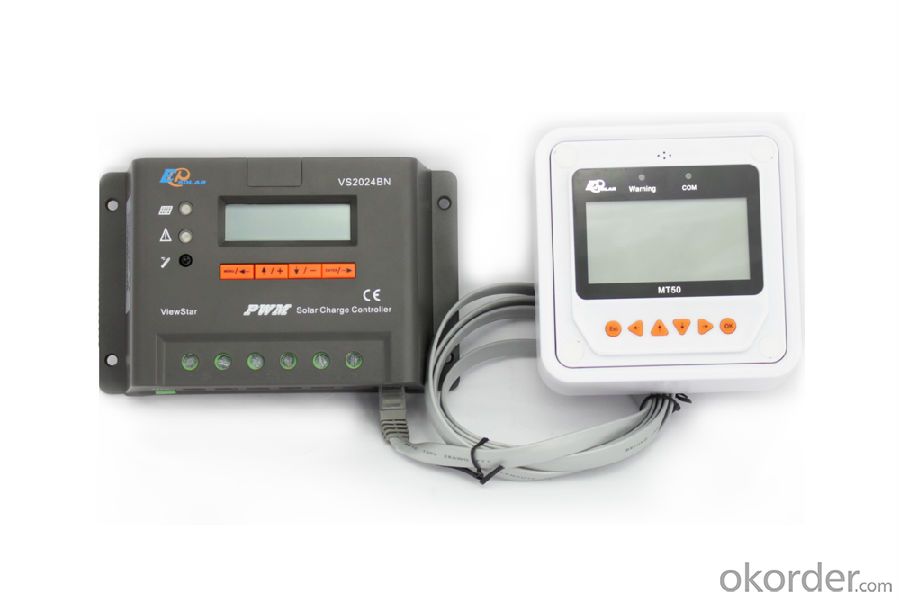
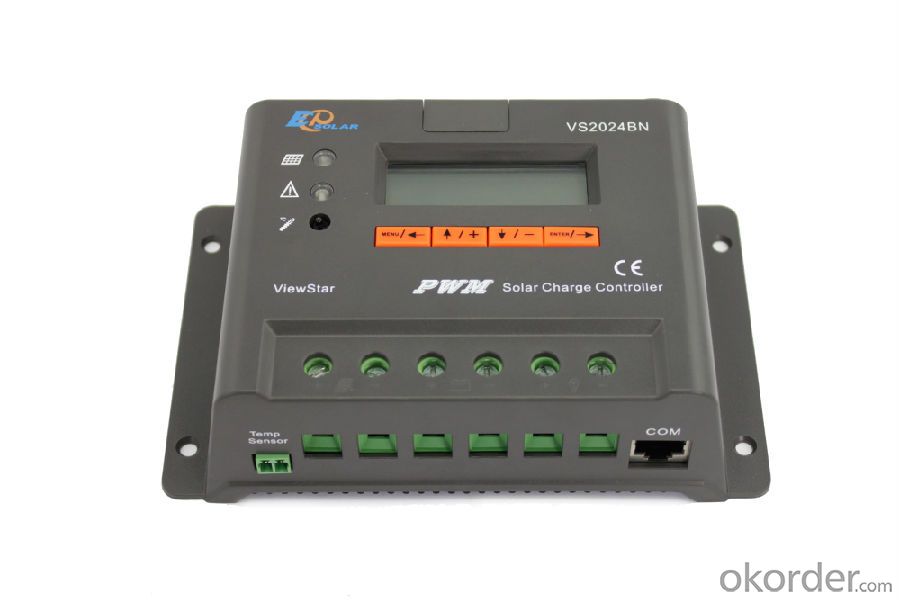
FAQ:
Q1. What is the voltage?
A1. Our 45/60A solar charge controller is 12/24/36/48V auto work.
Q2. What is the difference between MPPT&PWM?
A2. MPPT has higher efficiency, it can track the max power point and won't waste energy.
Q3. What is the efficiency of the MPPT controller?
A3. MPPT>99%, peak conversion efficiency>98%.
Q4. What is the waranty of product?
A4. 12 months.
Q5. What protection does your MPPT controller have?
A5. PV array short circuit, PV reverse polarity, Battery reverse polarity, Over charging, Output short circuit.
- Q: How do I install a solar controller?
- To install a solar controller, follow these steps: 1. Identify the suitable location for the controller near your solar panels and battery bank. 2. Mount the controller securely using screws or brackets. 3. Connect the positive and negative terminals of your solar panels to the corresponding terminals on the controller. 4. Connect the positive and negative terminals of your battery bank to the corresponding terminals on the controller. 5. Ensure all connections are tight and secure. 6. Finally, double-check the wiring and make sure everything is properly connected before switching on the controller.
- Q: What is the maximum number of solar panels that a solar controller can handle?
- The number of solar panels that a solar controller can handle depends on the controller's specifications and capabilities. Typically, the capacity of a solar controller is determined by its maximum input voltage and current rating. Solar panels generate direct current (DC) electricity, and the solar controller's role is to regulate and optimize the flow of this DC power. This is done in order to charge a battery bank or supply power to an electrical load. The controller must be able to handle the voltage and current produced by the solar panels without surpassing its own limitations. To determine the maximum number of solar panels that a controller can handle, it is necessary to consider the voltage and current ratings of the panels and compare them to the specifications of the controller. By dividing the maximum input voltage and current rating of the controller by the corresponding values of the solar panels, one can estimate the maximum number of panels that can be safely connected. It is crucial to note that surpassing the maximum capacity of a solar controller can result in performance issues, such as reduced efficiency, overheating, or even damage to the controller. Therefore, it is essential to carefully examine the specifications of the controller and ensure that the total voltage and current of the connected solar panels are within its limits. This is necessary for reliable and safe operation.
- Q: Can a solar controller be used with a solar-powered hydrogen production system?
- Yes, a solar controller can be used with a solar-powered hydrogen production system. A solar controller helps regulate the flow of electricity from the solar panels to the hydrogen production system, ensuring optimal charging and preventing overcharging or damage to the system. It helps optimize the efficiency and performance of the system by managing the energy generated by the solar panels.
- Q: Can a solar controller handle different battery types (e.g., lead-acid, lithium)?
- Yes, a solar controller can handle different battery types such as lead-acid and lithium. However, it is important to note that not all solar controllers are designed to support all battery types. Different battery chemistries require specific charging algorithms and voltage settings. Therefore, it is crucial to choose a solar controller that is compatible with the specific battery type you intend to use.
- Q: How does an MPPT solar controller differ from a PWM controller?
- An MPPT (Maximum Power Point Tracking) solar controller differs from a PWM (Pulse Width Modulation) controller in its ability to maximize the energy output from a solar panel. While a PWM controller simply regulates the voltage and current flowing from the panel to the battery, an MPPT controller actively tracks the maximum power point of the panel and adjusts its operating parameters accordingly. This allows an MPPT controller to extract the maximum amount of power from the solar panel, resulting in higher efficiency and potentially more energy generation.
- Q: Can a solar controller be used with a generator as a backup power source?
- Yes, a solar controller can be used with a generator as a backup power source. The solar controller regulates the charging and discharging of batteries in a solar power system, ensuring that the batteries are properly charged and protected. When a generator is used as a backup power source, the solar controller can still manage the charging process effectively, allowing for a smooth transition between solar power and generator power.
- Q: Can a solar controller be used in grid-tied systems?
- No, a solar controller cannot be used in grid-tied systems. Grid-tied systems do not require a solar controller as they are connected to the electrical grid and rely on inverters to convert the DC power generated by solar panels into usable AC power for the grid. A solar controller is used in off-grid systems to regulate and control the charging of batteries.
- Q: Can a solar controller be used with solar panel tracking mounts?
- Yes, a solar controller can be used with solar panel tracking mounts. A solar controller is designed to regulate and optimize the charging of batteries in a solar power system, irrespective of whether the solar panels are stationary or tracking the sun's movement.
- Q: Can a solar controller be used with solar-powered indoor irrigation systems?
- Yes, a solar controller can be used with solar-powered indoor irrigation systems. A solar controller is designed to regulate and optimize the solar power generated by solar panels, and it can be used to control and manage the irrigation system's power supply. By connecting the solar controller to the solar panels and the irrigation system, it can ensure that the system is powered efficiently and effectively. The solar controller can monitor the energy production, track the battery's charging status (if applicable), and automatically adjust the power output to meet the irrigation system's needs. This helps to maximize the system's performance and ensure that the irrigation system operates smoothly even in indoor environments.
- Q: Can a solar controller be used with a solar tracker?
- Yes, a solar controller can be used with a solar tracker. A solar controller is responsible for regulating the voltage and current from the solar panels to the batteries or grid, while a solar tracker helps optimize the angle and direction of the solar panels to maximize their efficiency. By combining both, the solar controller can adjust the charging parameters based on the position of the solar panels, ensuring optimal energy generation and storage.
Send your message to us
LCD/LED High Quality PWM Solar anel charge controller/regulator 10a 12/24v with CE ROHS 20A ,12V/24V,VS2024BN
- Loading Port:
- Tianjin
- Payment Terms:
- TT or LC
- Min Order Qty:
- -
- Supply Capability:
- 10000 pc/month
OKorder Service Pledge
OKorder Financial Service
Similar products
Hot products
Hot Searches
Related keywords
